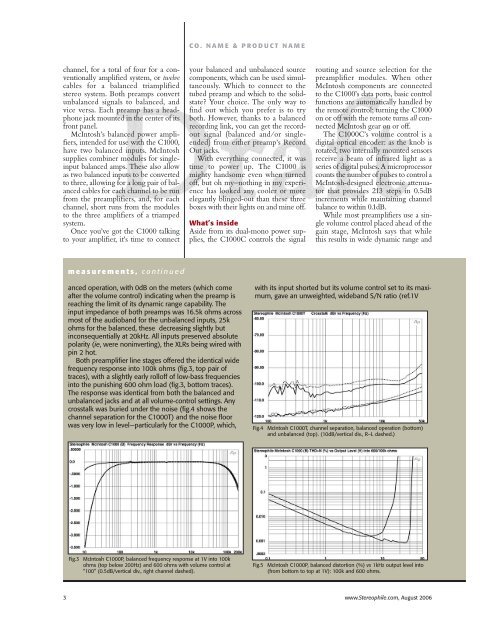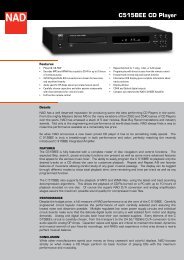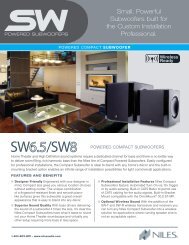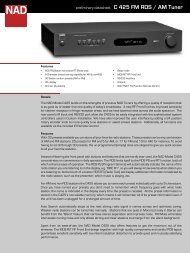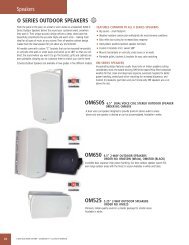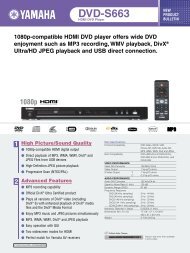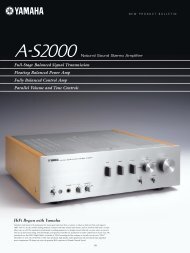MCINTOSH <strong>C1000</strong>totally over-the-top bling-bling of thethree-box <strong>C1000</strong> preamplifier system?It’s got three sets of glowing green letteringbehind glass, two sets of meters—even a row of tubes glowing sexily in a“storefront” window complete with aceiling mirror that doubles the visualdrama. And it costs only $26,000.<strong>The</strong> three-box solutionWhy argue over whether tubes orsolid-state sounds better when you canhave both? <strong>The</strong> <strong>C1000</strong> consists of the<strong>C1000</strong>C controller/power supply andtwo separate, fully balanced preamplifiers,one solid-state, one tubed. Oneneedn’t buy both preamps to go withthe <strong>C1000</strong>C controller, but I’d bet100% of buyers plunking down$17,000 for the controller ($8000) andone module ($9000) opt for both, forthat total of $26,000.<strong>The</strong> <strong>C1000</strong>C controller has knobsfor Volume, Balance (remember that?),Source selection, and the Record Outselector, and provides power and controlsignals to one or both preamplifiersvia individual umbilical cords foreach channel of each preamp.Aside from the amplificationmethodology, the <strong>C1000</strong>T (tube) and<strong>C1000</strong>P (transistor) preamps are identical,offering nine sources each,including both moving-coil (MC) andmoving-magnet (MM) inputs. <strong>The</strong>reare three sets of balanced inputs andfour sets of unbalanced, not includingthe unbalanced MM/MC inputs.Three sets of balanced outputs allowfor convenient triamping, if you’re soinclined. Two unbalanced outputsallow for biamping in unbalancedmode. Because each preamp has itsown inputs and outputs, double runs ofcables are required for each amplifierMEASUREMENTSIperformed full sets of measurements on both <strong>McIntosh</strong>preamplifiers, for both balanced and unbalancedoperation, but the two units turned out to be electricallyso similar that I’ve combined my comments onboth into a single sidebar.<strong>The</strong> phono stages, of course, are unbalanced only; Iexamined their behavior at each preamp’s Processor Outjacks. <strong>The</strong> MM stages of the <strong>C1000</strong>P and <strong>C1000</strong>T are noninvertingand offered a voltage gain of 40.1dB and aninput impedance of 47k ohms across most of theaudioband, the latter dropping inconsequentially to 42.5kohms at 20kHz. Both MC stages were also noninvertingand offered 60.1dB of voltage gain at 1kHz, with an inputimpedance of 30 ohms when set to “25” and 960 ohmswhen set to “1000.”<strong>The</strong> <strong>C1000</strong>P’s RIAA error (fig.1) showed a very slightexcess of energy in the upper bass and above theaudioband, but was otherwise flat. <strong>The</strong> <strong>C1000</strong>T’s RIAAerror (fig.2) was very similar at audible frequencies, butfeatured an increasingly positive error at ultrasonic frequencies.This suggests that the tube preamp’s phonostagegain asymptotically approaches unity with rising frequencyrather than, as I prefer to see, continuing todecrease. This behavior will not in itself be audible, butthe late John Linsley-Hood suggested a quarter centuryago that it might increase the audibility of record clicks,particularly with MC cartridges. Why would the two <strong>McIntosh</strong>preamps differ in this respect? I can surmise only thatthe more limited voltage gain available from tubes meantthat a different circuit topology had to be used.At normal levels, the phono-stages’ THD+noise wasaround 0.017%, which is excellent. Both tubed and solidstatephono stages excelled in a potentially more importantarea: their immunity to overload. <strong>The</strong> MM and MCstages of both the <strong>C1000</strong>P and <strong>C1000</strong>T offered a superb27dB or greater overload margin at all audio frequencies(ref. 5mV, MM, and 500µV, MC, both at 1kHz). <strong>The</strong> <strong>McIntosh</strong>preamps’ phono stages are also extremely quiet—theunweighted audioband signal/noise ratios were 78.5dB(<strong>C1000</strong>P) and 69.4dB (<strong>C1000</strong>T) from the preamps’ MMinputs, and only slightly lower from their MC inputs—meaning that, with their very high overload margins, theyhave commendably high dynamic range, especially thesolid-state <strong>C1000</strong>P. One thing should be noted about the<strong>C1000</strong>T: When I was exploring the point at which itsphono-stage output clipped at 20kHz, I experienced somelatching; ie, once the circuit had clipped, it stayed clippedeven after I’d reduced the input-signal level. However, asthe output level was around 12V when this happened, itshould have no practical consequences.<strong>The</strong> <strong>C1000</strong>P’s and <strong>C1000</strong>T’s line stages offered a maximumof 15dB of voltage gain in both balanced and unbal-Fig.1<strong>McIntosh</strong> <strong>C1000</strong>P, MM stage RIAA error (0.5dB/vertical div., rightchannel dashed).Fig.2<strong>McIntosh</strong> <strong>C1000</strong>T, MM stage RIAA error (0.5dB/vertical div., rightchannel dashed).www.<strong>Stereophile</strong>.com, August 2006 2
CO. NAME & PRODUCT NAMEchannel, for a total of four for a conventionallyamplified system, or twelvecables for a balanced triamplifiedstereo system. Both preamps convertunbalanced signals to balanced, andvice versa. Each preamp has a headphonejack mounted in the center of itsfront panel.<strong>McIntosh</strong>’s balanced power amplifiers,intended for use with the <strong>C1000</strong>,have two balanced inputs. <strong>McIntosh</strong>supplies combiner modules for singleinputbalanced amps. <strong>The</strong>se also allowas two balanced inputs to be convertedto three, allowing for a long pair of balancedcables for each channel to be runfrom the preamplifiers, and, for eachchannel, short runs from the modulesto the three amplifiers of a triampedsystem.Once you’ve got the <strong>C1000</strong> talkingto your amplifier, it’s time to connectyour balanced and unbalanced sourcecomponents, which can be used simultaneously.Which to connect to thetubed preamp and which to the solidstate?Your choice. <strong>The</strong> only way tofind out which you prefer is to tryboth. However, thanks to a balancedrecording link, you can get the recordoutsignal (balanced and/or singleended)from either preamp’s RecordOut jacks.With everything connected, it wastime to power up. <strong>The</strong> <strong>C1000</strong> ismighty handsome even when turnedoff, but oh my—nothing in my experiencehas looked any cooler or moreelegantly blinged-out than these threeboxes with their lights on and mine off.What’s insideAside from its dual-mono power supplies,the <strong>C1000</strong>C controls the signalrouting and source selection for thepreamplifier modules. When other<strong>McIntosh</strong> components are connectedto the <strong>C1000</strong>’s data ports, basic controlfunctions are automatically handled bythe remote control; turning the <strong>C1000</strong>on or off with the remote turns all connected<strong>McIntosh</strong> gear on or off.<strong>The</strong> <strong>C1000</strong>C’s volume control is adigital optical encoder: as the knob isrotated, two internally mounted sensorsreceive a beam of infrared light as aseries of digital pulses. A microprocessorcounts the number of pulses to control a<strong>McIntosh</strong>-designed electronic attenuatorthat provides 213 steps in 0.5dBincrements while maintaining channelbalance to within 0.1dB.While most preamplifiers use a singlevolume control placed ahead of thegain stage, <strong>McIntosh</strong> says that whilethis results in wide dynamic range andmeasurements, continuedanced operation, with 0dB on the meters (which comeafter the volume control) indicating when the preamp isreaching the limit of its dynamic range capability. <strong>The</strong>input impedance of both preamps was 16.5k ohms acrossmost of the audioband for the unbalanced inputs, 25kohms for the balanced, these decreasing slightly butinconsequentially at 20kHz. All inputs preserved absolutepolarity (ie, were noninverting), the XLRs being wired withpin 2 hot.Both preamplifier line stages offered the identical widefrequency response into 100k ohms (fig.3, top pair oftraces), with a slightly early rolloff of low-bass frequenciesinto the punishing 600 ohm load (fig.3, bottom traces).<strong>The</strong> response was identical from both the balanced andunbalanced jacks and at all volume-control settings. Anycrosstalk was buried under the noise (fig.4 shows thechannel separation for the <strong>C1000</strong>T) and the noise floorwas very low in level—particularly for the <strong>C1000</strong>P, which,with its input shorted but its volume control set to its maximum,gave an unweighted, wideband S/N ratio (ref.1VFig.4<strong>McIntosh</strong> <strong>C1000</strong>T, channel separation, balanced operation (bottom)and unbalanced (top). (10dB/vertical div., R–L dashed.)Fig.3<strong>McIntosh</strong> <strong>C1000</strong>P, balanced frequency response at 1V into 100kohms (top below 200Hz) and 600 ohms with volume control at“100” (0.5dB/vertical div., right channel dashed).Fig.5<strong>McIntosh</strong> <strong>C1000</strong>P, balanced distortion (%) vs 1kHz output level into(from bottom to top at 1V): 100k and 600 ohms.3 www.<strong>Stereophile</strong>.com, August 2006


